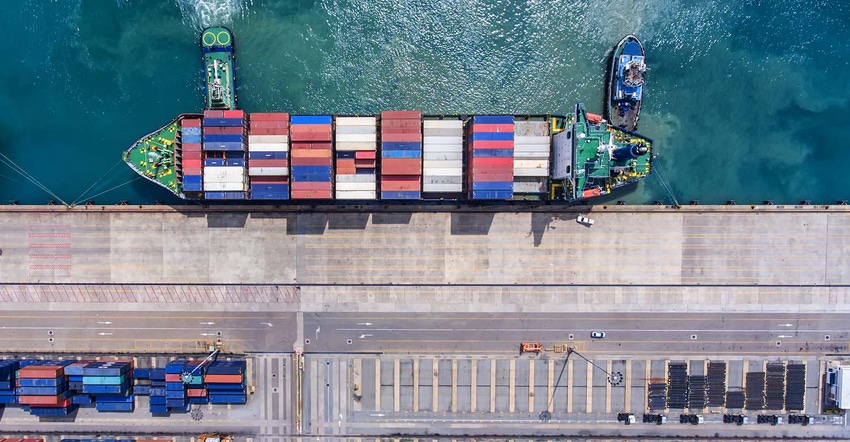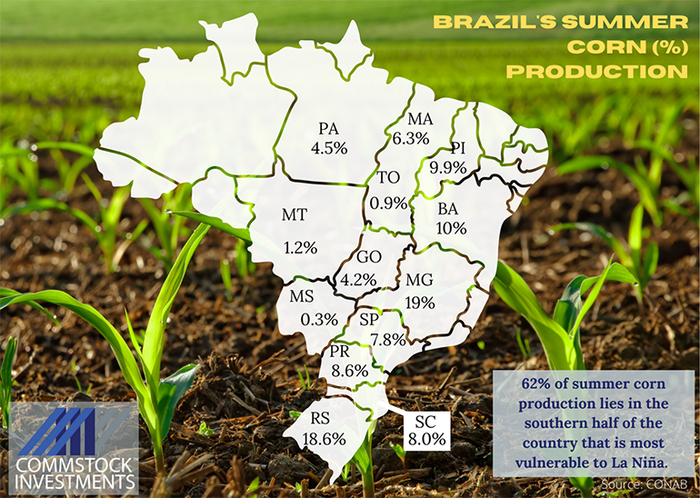
The first crop of corn planting in Southern Brazil is making strong progress with some reports of farmers already finishing and getting ready to switch to soybeans.
So far Rio Grande do Sul has had excellent rainfall. However, forecasts are still calling for a drier October which could lead to issues with poor stand. The start of the 2022 first corn harvest is already pegged for early January as initial corn seedings are off to a good start.
While the first crop of corn only makes up a third or less of Brazil’s total corn production, it can still have an impact on ending stocks. Dry weather at planting last year hurt yields, which resulted in a first crop production of 23 Million Metric Tons. This compares to the 32 MMT they are estimating for next season.
Shrinking crop
USDA reduced Brazil’s second corn crop size by 1 MMT from last month, dropping it from 87 to 86 MMT. Average estimates thought it would come in closer to 85 MMT, which is closer to where CONAB has estimated the Brazil crop. Private estimates are still looking for further reductions closer to 82 MMT, but it will take more time for government estimate revisions.
Brazilian corn exports
Brazilian corn exports are still delivering on old contracts, which continue to indicate that exports will fall well short of 20 MMT, coming in closer to 18 MMT (USDA is at 22 MMT). Brazil was originally expecting 35 MMT of corn exports at the start of last season, so they have virtually been cut in half. This represents nearly 500 to 700 million bushels of corn supply that disappeared from the global market.
Prices have yet to reflect this in the marketplace, as markets have been leaning lower for the last several weeks, with local (Brazil) futures prices currently trading around $7.40 per bushel.
Summer production
Brazil’s summer corn production – that’s our winter, in the northern hemisphere - is highly concentrated in the Southern region of the country, with approximately 35% being grown in Rio Grande do Sul, Santa Catarina, and Parana.
The Southeast region is also increasing its production area, mostly due to the state of Minas Gerais which produces nearly 19% and is expected to have the largest production area by state for summer corn production. This means the southern half of the country is responsible for roughly 62% of the summer crop production. But it’s also the area expected to be most impacted by a La Niña.

Soybean planting
The soybean planting window has barely opened in most states, and it won’t pick up until next month. States like Mato Grosso were not even allowed to plant soybeans until Thursday of last week. That’s because the Ministry of Agriculture has adopted strict phytosanitary laws that dictate when certain crops cannot be planted. This is done to help “cleanse” fields from the spread of insects and diseases, especially those like Asian Rust. Violations can lead to stiff fines. In the U.S., this process happens naturally through winter.
Since most of Brazil’s growing areas remain warm year-round, they must establish rules such as these. Other states have even later planting windows established. The state of Bahia cannot begin planting until October 1st. Parts of Piaui and Maranhão cannot begin until even later. This is evidence that we are still at the early stages of the planting window and there is still plenty of time for farmers to get their crops in. While the primary planting window may be 30 days off yet in Mato Grosso, you can still find farmers trying to get an early start.
Matthew Kruse is President of Commstock Investments. He can be reached at 712-227-1110.
Futures trading involves risk. The risk of loss in trading futures and/or options is substantial and each investor and/or trader must consider whether this is a suitable investment. Past performance is not indicative of future results. Trading advice is based on information taken from trades and statistical services and other sources that CommStock Investments believes to be reliable. We do not guarantee that such information is accurate or complete and it should not be relied upon as such. Trading advice reflects our good faith judgment at a specific time and is subject to change without notice. There is no guarantee that the advice we give will result in profitable trades.
The opinions of the author are not necessarily those of Farm Futures or Farm Progress.
Read more about:
BrazilAbout the Author(s)
You May Also Like






